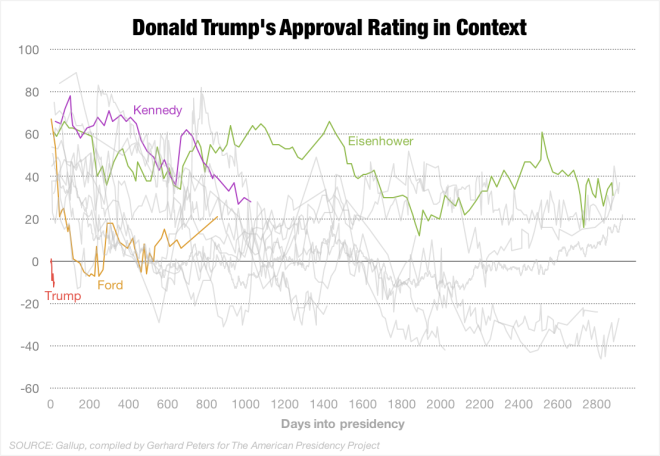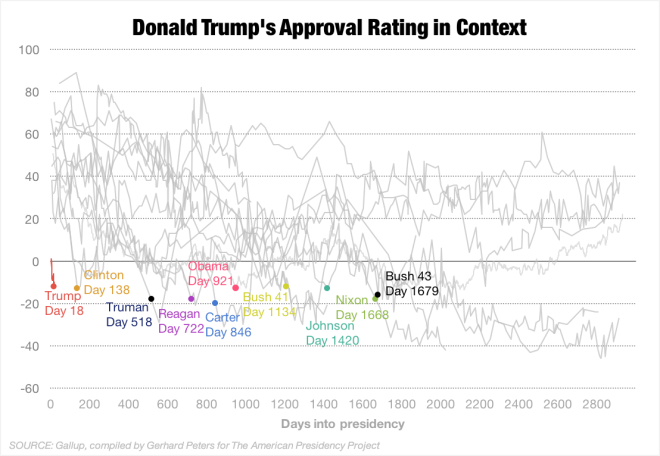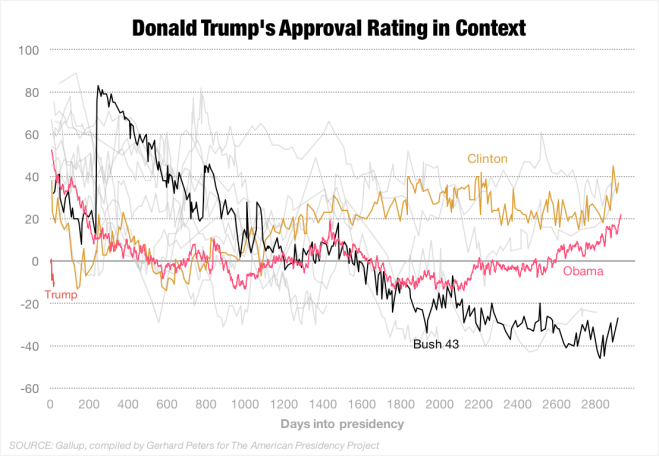Just how bad is Donald Trump’s approval rating, historically speaking?

It has already been pointed out that the current President rose to majority disapproval far more quickly than any other president, but I wanted to take a closer look at how his current standing compares to the record of other Presidents. Clearly, it is very early (actually, that’s sort of the point) and far too early to draw any serious conclusions, but still, it’s an interesting question from a historical perspective.
At the top of this post is the Gallup net-approval rating – that’s percent approval minus percent disapproval – for every President going back to Harry S. Truman, the first for whom there’s early-Administration polling. Trump’s net-approval is -10 today, up slightly from -12 yesterday. Clearly, this is low. The average rating for presidents during this period is +49, ranging from +23 for Bill Clinton to +75 for a post-JFK assassination Lyndon Johnson (though Truman, who was busy wrapping up a World War, scored +84 in his first poll on day 48).
In fact, three presidents – Eisenhower, Ford and Kennedy – never scored as low as Trump is now, for the entirety of their time in the White House. However, two of them did not even serve four years in office, restricting their ability to disappoint the country.

For the others, it took much longer to reach this far into the presidential doldrums. The closest second is Bill Clinton, who reached -13 in a poll conducted during June of his first term. The earliest stages of Clinton’s presidency saw the Travelgate controversy draped over an already scandal-clad President, who won election with only 43% of the vote. For other presidents it took much longer: next in line was Truman, who dropped below -12 a full year and a half into his tenure. On the other end of the scale are George W. Bush and Richard Nixon, both of whom wouldn’t fall below Trump’s current level until their second terms.

The Bush and Nixon examples reintroduce some nuance into our assessment of Trump’s current standing. George W. Bush took longer to hit this level than any other modern president, but ended his time at the White House with lower ratings than any other resident who lasted a full two terms. Bill Clinton, though he got off to a uniquely rough start, ended up with some of the highest approval ratings of any two-termer. This point is captured compellingly in a recent piece by Princeton historian Julian Zelizer, who recounts Ronald Reagan’s answer to public protest, international disorder and low approval ratings: decisive re-election.

All the same, it’s hard to ignore how Trump in not even three weeks has reached depths that usually inspire media folklore of presidencies trawling across the ocean floor, searching for direction. Here are some comparable periods for recent Presidents, who faced some of the same partisan pressures that likely delimit both the floor and the ceiling of the modern-day approval rating:
| Bill Clinton | Paula Jones suit, Whitewater hearings, death of Hillarycare | Sep. 1994 | -10 |
| George W. Bush | Hurricane Katrina and Aftermath | Sep. 2005 | -9 |
| Barack Obama | Debt-ceiling crisis, S&P downgrade | Aug. 2011 | -11 |
| Donald Trump | Two weeks as President | Feb. 2017 | -10 |
In addition, were Trump’s ratings to remain in their current territory for the next 20-odd months, history suggests his party would be headed for a solid rebuke at the Midterm elections. Every president with an approval rating under 55% has lost House seats in the midterms, and losses for presidents under 50% range from 11 seats (1978) to 63 (2010). Notably, Democrats need to gain only 24 seats to retake control of the House of Representatives, and the only circumstance where a president lost fewer than that with comparable ratings was 2014, when an already diminished Democratic Party lost 13 seats six years into Obama’s presidency. The average seat loss for a president in the 39% to 46% approval range is 39. Trump is at 43%.

Of course, nothing about Donald Trump or his campaign for president has fit into the template of the average President. And in 2016, House Democrats lost double the number of districts won by Hillary Clinton than Republicans who lost Trump districts, and it’s possible they will repeat the performance in 2018. But a repeat performance would require Trump to break dramatically with history, once again.
The Bush II line is worth noting. It’s hard to imagine that he could have won a second term without 911. I call it a cautionary tale anyone who thinks Trump will be a one-term president. If something sufficiently tragic occurs, his line could end up looking like Bush’s. I take no pleasure in saying this.
LikeLiked by 1 person
I see your point, but can you imagine Donald Trump handling a tragedy like 9/11 even close to how 43 handled it? If the USA is attacked on Trump’s watch (god forbid), his first move will almost certainly be to grab his phone and tweet about how he knew this was going to happen, everyone who opposes him is to blame, etc. etc. I cannot see any scenario where the opponents of this president rally behind him and give him a 90% approval rating. His toxicity and narcissism has already cost him any feelings of goodwill, no matter how slight, the Democrats felt towards him.
LikeLiked by 1 person
[…] I just love a good chart or two… here’s a nice comparison of Rump’s approval ratings versus approval ratings of president… […]
LikeLike
[…] charts/ Trump’s approval rating in context. Just how bad is Donald Trump’s approval rating, historically speaking? (Borderline) […]
LikeLike
[…] The far-right appears to not be learning from this eye-opening revolution; insight is not growing in this group. They appear to be digging their heels into an already-entrenched mindset of bigotry and self-aggrandizement that Trump all too readily embodies and encourages. We can only hope, though, that this vocal group is a small one. We can hope that with more national and grassroots dialogue, this group will continue to shrink. Our country has challenged elitism and closed-mindedness in many ways in the past. I see this currently as Trump is losing his following at an impressive rate. […]
LikeLike